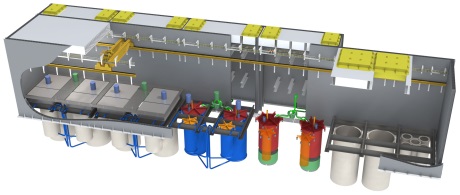Martingale Inc has unveiled its ThorCon liquid-fuel nuclear reactor design, which uses uranium and thorium fuel dissolved in molten salt. Production is expected to start by 2020.
"We have a very interesting design that has not been previously revealed. It's interesting because it's a molten salt reactor, it's produced in shipyard-like factories, and can be cheaper than coal," Jack Devanney, the principal engineer and architect of the molten salt reactor power plant, told World Nuclear News yesterday.
 |
| The ThorCon Power nuclear island would be located below ground (Image: Martingale) |
A former professor at Massachusetts Institute of Technology - a private research university in Cambridge, Massachusetts - Devanney said his background in shipbuilding "created respect for low-cost, high-precision, block-unit manufacturing" at Korean shipyards. He saw "how such prefabricated blocks could enable production of enough nuclear power plants to make a global difference, a hundred a year."
Florida, USA-based Martingale has not patented unique devices such as the membrane wall for cooling.
"Public disclosure enables free exchange of ideas across national boundaries without potential delays imposed by governments concerned with regulating information related to nuclear power," Devanney said.
The company advocates a return to staged testing of physical prototypes for new nuclear reactor designs. This made the USA "the world standard" for nuclear designs in the 1960s, it said.
The company also "supports adoption of the same license-by-test model that has enabled the USA's leadership in aviation and drug discovery."
Molten salt reactors are still at the design stage but are likely to be very well suited for using thorium as a fuel. The unique fluid fuel can incorporate thorium and uranium (U-233 and/or U-235) fluorides as part of a salt mixture that melts in the range 400-700ºC, and this liquid serves as both heat transfer fluid and the matrix for the fissioning fuel.
The fluid circulates through a core region and then through a chemical processing circuit that removes various fission products (poisons) and/or the valuable U-233. The level of moderation is given by the amount of graphite built into the core. Certain molten salt reactor designs will be designed specifically for thorium fuels to produce useful amounts of U-233.
Researched and written
by World Nuclear News




_33584.jpg)
_82983.jpg)
_49382.jpg)
_34792.jpg)





